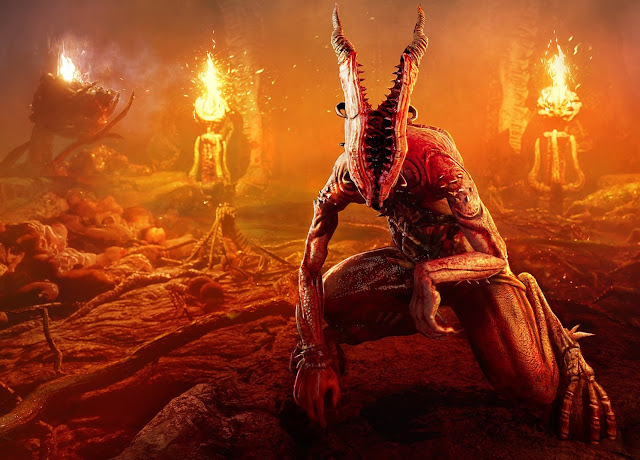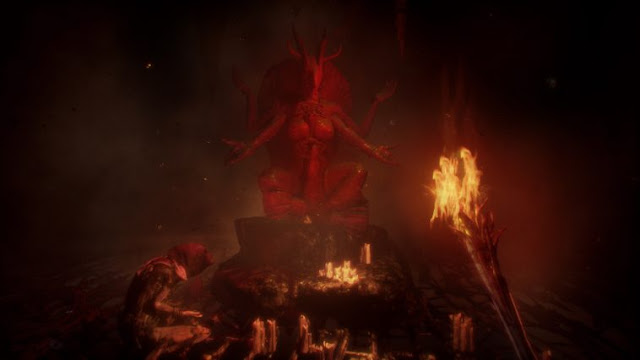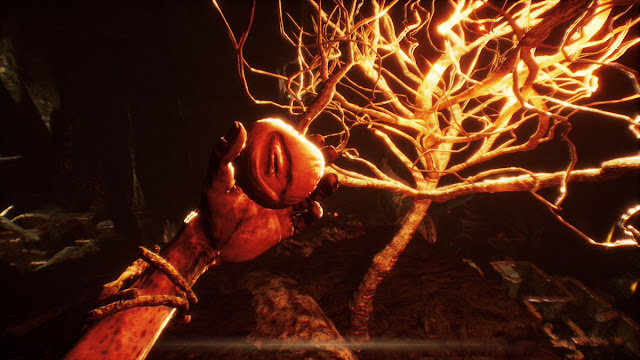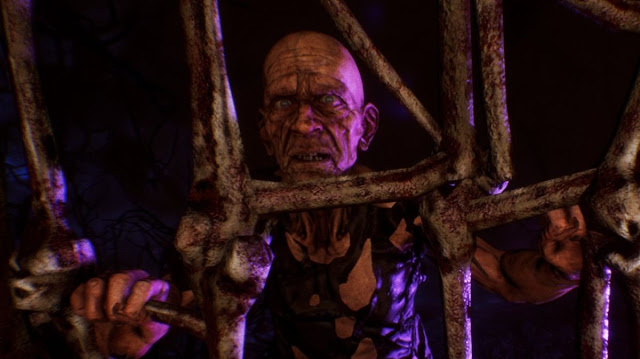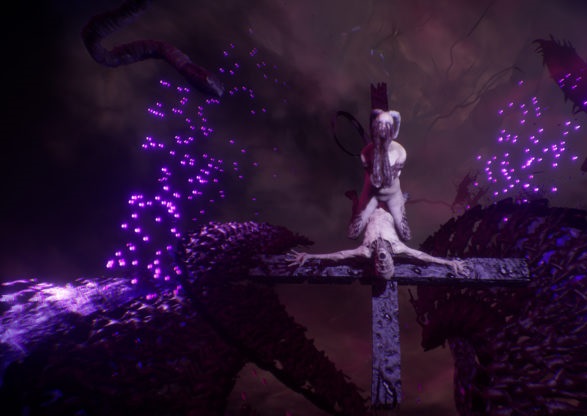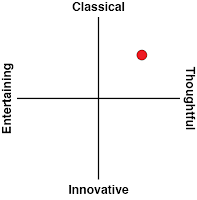Review by Matt S.
I sympathise with any developer that tackles hell as a topic and setting for their work. Especially the Judeo-Christian concept of hell. See, the problem with hell is that it, by its very nature, needs to be depraved. It needs to be shocking, grotesque and extreme. It is, after all, the most extreme manifestation of a raw, unfiltered evil that humans can conceive.
Outside of video games, there are plenty of examples of artists taking a largely unfiltered approach in describing or depicting hell. Dante Alighieri’s poetry is probably the most famous example of a depiction of hell that’s we’ve got, and while most people can’t actually read that poem any longer (translated into modern language or not, it is so archaic that requires a very complex understanding of classical poetry to decipher) it remains incredibly influential in how we understand hell as a philosophical concept. But there are plenty of others that have tackled the concept too. The painter, Hieronymus Bosch, for example. His vision of hell was truly nightmarish.
Inside of the world of video games, it’s a different story. There’s a resistance at all levels – consumer, critic and developer – to games that would genuinely distress the player. Perhaps it’s because these mediums are more dynamic, being moving images and, in the case of games, interactive and therefore, we reason, the impact of them is higher. Or perhaps it’s because the expectations of a video game is that it should exist purely for the purposes of entertainment and the mass market, so anything that aims explicitly to distress must therefore be a flawed product even if it succeeds at that. Regardless of the reason, to date every attempt at depicting hell (again, the Judeo-Christian interpretation of it) has been overly sanitised (Dante’s Inferno), or reworked completely into something that instead subverts the expectations of hell, often in the name of humour or grindhouse-style attitude (Shadows of the Damned). Agony is the first game to have willingly stepped off the precipice and thrown its players into something extreme enough that most will find revolting.
Coming to us from a Polish developer, and part of the emerging trend among Polish development to craft these highly transgressive experiences (with transgression running the gamut from the incendiary violence of Hatred through to the shockingly powerful anti-war commentary of This War of Mine), Agony is extreme. Extreme enough that even the censors of the very anti-censorship American ESRB got involved and essentially mandated that some material be removed from the game. Even then, what was removed has more to do with following the letter of the law, and the greater sensitivities that censorship boards have towards content that features depictions of sexual activity. In fact, I’d struggle to even say that the stuff that has been cut out of it is the most affecting stuff you’ll see in the game because the raw violence, where there are fewer sensitivities, is still pushed to a sickening degree, and no one was interested in getting that removed (I won’t link to the cut footage, but it is available on the Internet if you’re so inclined to put yourself through watching it).
There’s barely a second of respite in Agony. The intensity of the atmosphere itself is more claustrophobic than the game’s corridor structure could ever be. I had to take pretty regular breaks while playing the game, and I have a well-beyond-average tolerance for this kind of stuff. It’s uncomfortable, it’s brutal, and I’ll be upfront now, I simply can’t recommend it to anyone because there’s every chance that it’s going to upset you.
But.
But that’s the point of Agony. That’s exactly what this game needed to be. This is the visual that DOOM should have provided when Bethesda’s suit-wearing executives got up on stage that E3 a few years ago and promised us “a trip into hell.” That overly corporate vision of hell ended up being a few chains and pentagrams around the place, and it was a massive disappointment. Agony is vastly less enjoyable to play than DOOM, but the purity in which the developer has delivered on what it promised deserves respect.
Equally, the purpose driving the game is quite sublime. Compared to something like Outlast 2, which is also extreme in nature but done so with absolutely no rhyme and reason beyond “how can we make this as extreme as possible,” at least Agony has a point. Agony is there, much like an Hieronymus Bosch painting, to put the depictions of the Judeo-Christian hell above any other consideration. This means that it does some silly things, like expressing an almost comical fear of sexuality and women. So much of the depravity in Agony spins around visual motifs of female anatomy, and the monstrous machinations of the woman demon at the centre of it all. On the one hand, it’s easy to chalk that up as both trashy and juvenile. On the other hand, that’s exactly what the Christian hell would indeed look like. At every step of the way in Agony, where the developers had the choice between sacrificing a pure vision of the Judeo-Christian hell for something that’s more contemporary, the developers went with the purity.
Visually, Agony is quite beautiful, in the depraved vision that it aims for. The journey through the game does a good job of keeping each region looking distinct to one another, and along the way what you see being done to hapless souls by monstrous demons is memorable, to say the least. The painful contortions, the blasphemy, the bloodletting, and the persistent soundscape of exquisite screaming and rending flesh never gives you a moment of air, nor the sense that your own avatar is ever safe themselves. It’s a pity that the voice performances are so pedestrian and/or cliche to the point that they lose impact, but beyond that, again, everything in Agony comes together to achieve something deeply unsettling.
Agony’s biggest problem, beyond being so extreme that even the most casual horror game fans are at risk of finding it to be too much, is that it tries too hard to be a game. Something I’ve always found to be so fascinating about Dante Alighieri’s poetry is that he effectively wrote a “walking simulator.” Dante made himself the protagonist of the story, as he was guided though hell by the great poet Virgil, in a narrative structure that very closely mirrors the storytelling of the typical walking simulator – you, the avatar, being guided by one or more “voices,” each filtering the story to you, contextually, based on where you are and what you are doing at that point of time.
If Agony did the same and simply gave you a guided tour of its vision of hell, it could have easily been as effective as something like Layers of Fear – a game that most would agree is a highly effective example of raw horror storytelling through the videogame medium. Instead, the developers put “gameplay” in… and the gameplay is just terrible.
In principle Agony offers a mix of puzzles to solve, and stealth sections, where you need to avoid the attention of powerful demons. There’s no way to fight back against most of them, so you need to toss your torch away (the light attracts the demons), hold your breath, and wait for them to move on. We’ve seen plenty of stalker horror games in the past (Amnesia being perhaps the best example), but a combination of bugs and absolutely dismal guidance from the game makes this one a very painful grind to work through, filled with trial and error deaths and far too few checkpoints for this kind of gameplay.
Other parts of the game are simply poorly thought out. If a demon does grab and kill you, you’ve got a short period of time for your soul to go find a new host to possess, but the layout of candidates for possession within the level renders this feature more an annoyance itself than the lifesaver that it pretends to be. Puzzles, meanwhile, are irritating to try and work through – not necessarily challenging, just poorly explained, so you’ll spend time wandering around confused trying to figure that out. For a game that’s all about the hellish atmosphere, that downtime is a thematic punch to the gut. Finally, while it’s possible to conjure up a little glowing path that shows you were to go next, you’re limited in how many times you can use that – a pointless, arbitrary restriction – and even when you do use it, the moment the path points up a rise (such as a staircase) you’ll lose sight of it and, thanks to your slow movement pace, by the time you get up there your guidance line is gone.
And there are bugs. Of course there are bugs. I managed to corrupt a save file not once, but twice, and do you know what the quickest way to crush a game’s atmosphere is? Force players to replay half the game just to push on with the new stuff. I usually don’t note bugs in my game reviews because I assume that they’re going to be patched out or fixed. Especially critical ones like save file corruption. And in fairness the developer looks like it’s actively listening to the criticism in this area, since there has already been a patch released which deals with the terrible screen tearing issues the game had on PS4 Pro. But there are just so many bugs in Agony that it’s hard to imagine every one of them being patched in even the medium term, and in a title like this, every single inconsistency that a bug introduces into the experience compromises the atmosphere and vision of the game.
I can’t for the life of me understand why the developers, who put such an earnest effort into recreating a true vision of the Judeo-Christian hell, would let some arbitrary need for gameplay let their work down. Especially when, well over half a millennia ago, Dante Alighieri already wrote the textbook on how to depict hell. Hell works best as a journey where one wave of the most exquisite horrors after the next can wash over the audience. The fewer filters there that slow things down (such as gameplay), the more the player can focus on that horrifically vivid imagery, and the stronger the work will be as a result. I have all the respect in the world for what the developers set out to achieve with Agony, because it is something that will never be friendly from a commercial point of view, and unlike extreme trash like Outlast and its sequel, this one has a genuinely good reason to be extreme. In the end, though, Ninja Theory’s Hellblade, despite being a very different vision of a journey to hell, remains the most effective example we’ve yet seen in video games.
– Matt S.
Editor-in-Chief
Find me on Twitter: @digitallydownld
 |
| Please Support Me On Patreon!
|

